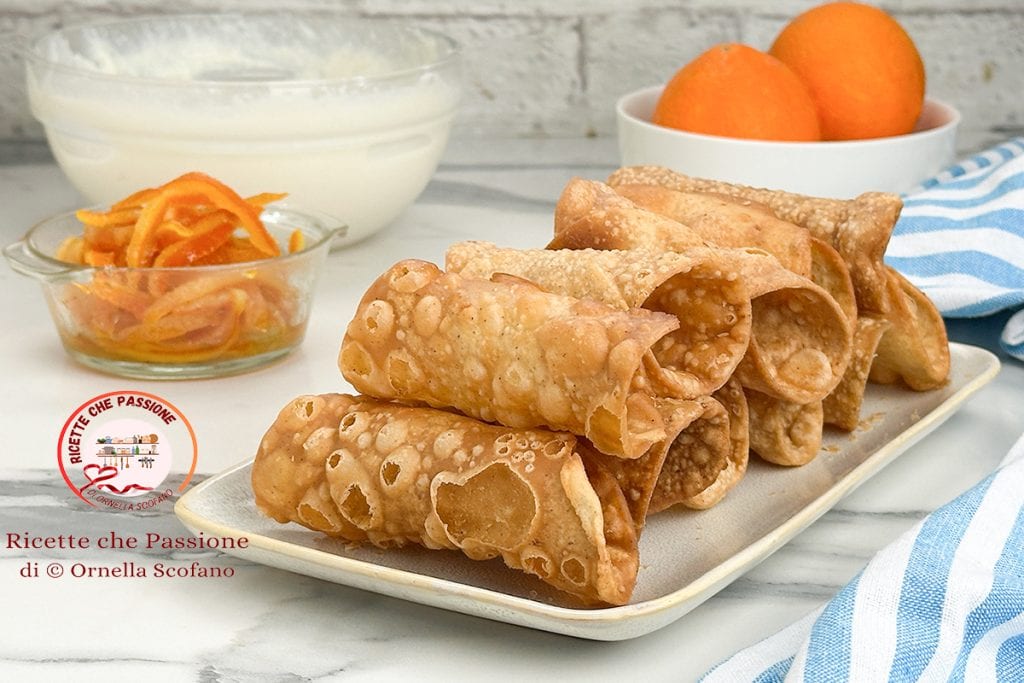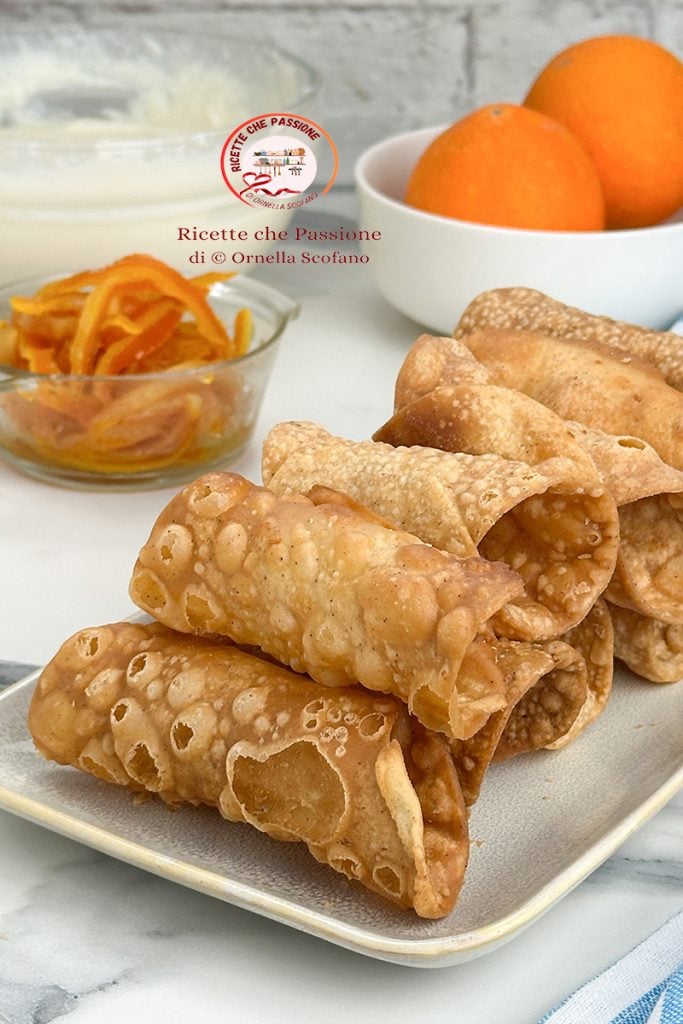Sicilian cannoli shells are fried pastry shells, flavored with cinnamon, and typically stuffed with ricotta cream. Sicilian cannoli shells can be made at home simply and quickly. For this recipe, steel or aluminum cylinders are essential, or as in the past, dry reeds were used, cut, and the dough was wrapped around them to fry in plenty of hot oil. To prepare thin shells, I used a pasta machine, but I assure you that you can achieve excellent results with a rolling pin as well, perhaps slightly thicker but equally good, crunchy, or full of bubbles. I made them very thin, stopping at the second-to-last thickness setting of my pasta machine, so they are lighter, and eating a cannoli doesn’t feel heavy. From this batch, I made about 24 thin shells, but if desired, you can make them slightly thicker by stopping at the previous setting, in which case you’ll have about half the shells, at least 12, just like when rolled with a pin, as I’ve tried before. So decide how you prefer them: more or less thin. Keep in mind that mine are quite thinner than those usually found in pastry shops but very crunchy and flaky with exceptional taste. Depending on the quantity, you’ll need more or less ricotta, at least 50g of sheep ricotta for 12 cannoli, double that for 24.

- Difficulty: Easy
- Cost: Very economical
- Rest time: 1 Hour
- Preparation time: 10 Minutes
- Portions: 24
- Cooking methods: Frying
- Cuisine: Italian
- Seasonality: All seasons
Ingredients for Sicilian Cannoli Shells
- 1 1/2 cups all-purpose flour
- 1 medium egg
- 1/2 tsp cinnamon
- 1/2 tsp unsweetened cocoa powder
- 1 1/2 tbsps lard
- 2 tbsps Marsala wine
- 1 1/2 tbsps sugar
- 1 tbsp white wine vinegar
- 1 pinch salt
- as needed orange zest
- as needed sunflower oil
Tools for Preparing Sicilian Cannoli Shells
- 1 Bowl
- 1 Grater
- 1 Pasta Machine
- 12 Metal Cylinders
- 1 Small Pot
- 4 Paper Towels
- 1 Fork
- 1 Tray
- 1 Cookie Cutter 4 inches
Steps to Prepare Sicilian Cannoli Shells

In a large bowl, grate the zest of an orange or lemon, preferably organic. Add sugar, and start mixing to release all the aroma of the zest, then add the cold lard from the fridge and mix again. Finally, add the flour, and work until you get a sandy mixture. Add cinnamon and cocoa and mix.
Then add all the liquid ingredients: Marsala, or alternatively a spirit like rum, a medium egg, and the vinegar in which you dissolve a pinch of salt. Work until you get a homogeneous dough, better on a work surface.
Put the dough back into a bowl, cover with cling film, and refrigerate for at least an hour, two hours is also fine.
Quickly knead the dough, and if it is too soft, use a little flour, divide into 2 parts, and start working with the pasta machine, or alternatively, roll out with a rolling pin.
Start with the rollers open and repeat several times, folding the sheet to get a uniform dough. Then gradually tighten the rollers to thin it out. Cut the sheets short enough and place them on a floured surface. Stop at the second-to-last setting or the previous one. This small difference will determine whether your cannoli are thin or thicker, which affects the number of shells obtained, from 24 to about 12, as thinning doubles the length of the dough.
With a 4-inch cookie cutter, cut out disks. Gather leftovers and roll out again to make more shells.
To prepare the shells, at least 12 cylinders are required, or at least 6, so you don’t have to wait too long for them to cool down before reuse. I advise against waiting too long; otherwise, the dough dries out too much, and there’s a risk of cannoli opening during frying.
Wrap each disk around a cylinder, dampen overlapping edges with a bit of water, being careful not to wet the cylinder but just the dough, and press well to seal. Many recipes suggest using an egg, but I’ve always used water and never had issues.
Fry in ample hot oil at about 350°F. Drop the cylinders into the oil, letting them fall from the tip so you don’t burn yourself. Let them brown in the oil and then drain on paper towels, lifting them gently with a fork to let all the oil drip from the cylinder. Let them cool a bit, then remove them from the cylinders, which you reuse to prepare all remaining shells. Continue until complete.
Once cooled, store well-sealed and fill right before serving with a good ricotta cream, so the shells will keep longer.
If you want to make them more indulgent, you can add a dark chocolate coating inside.

